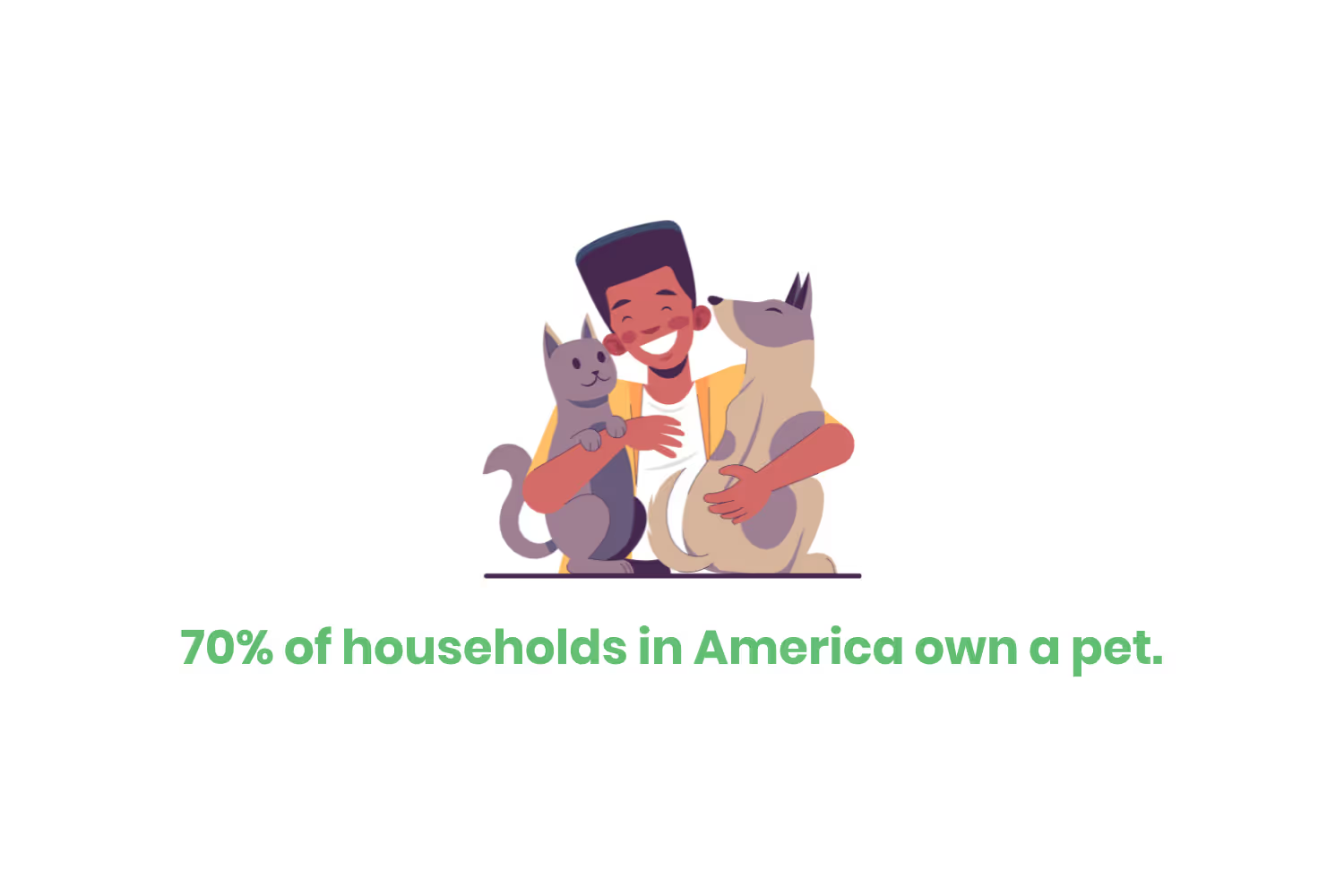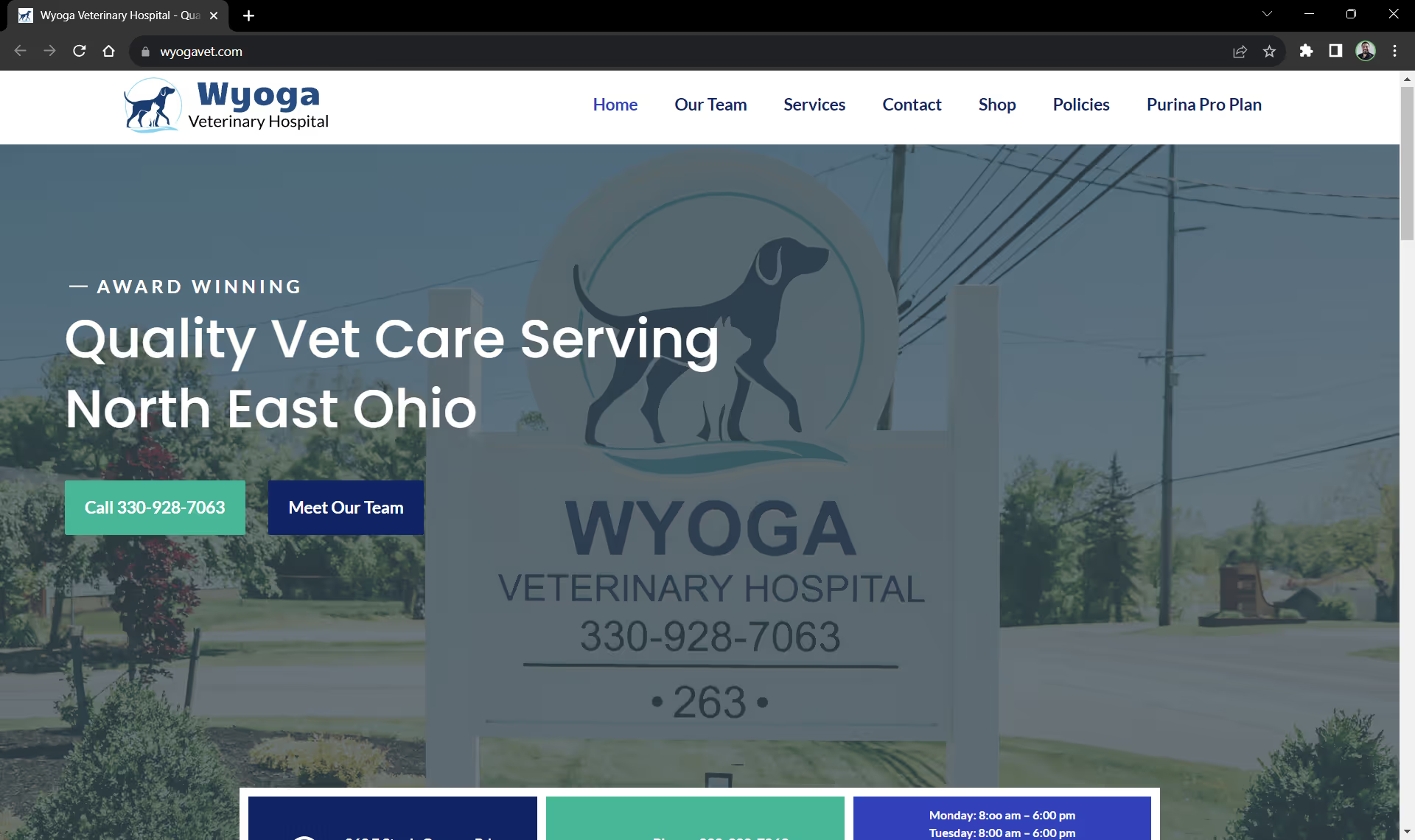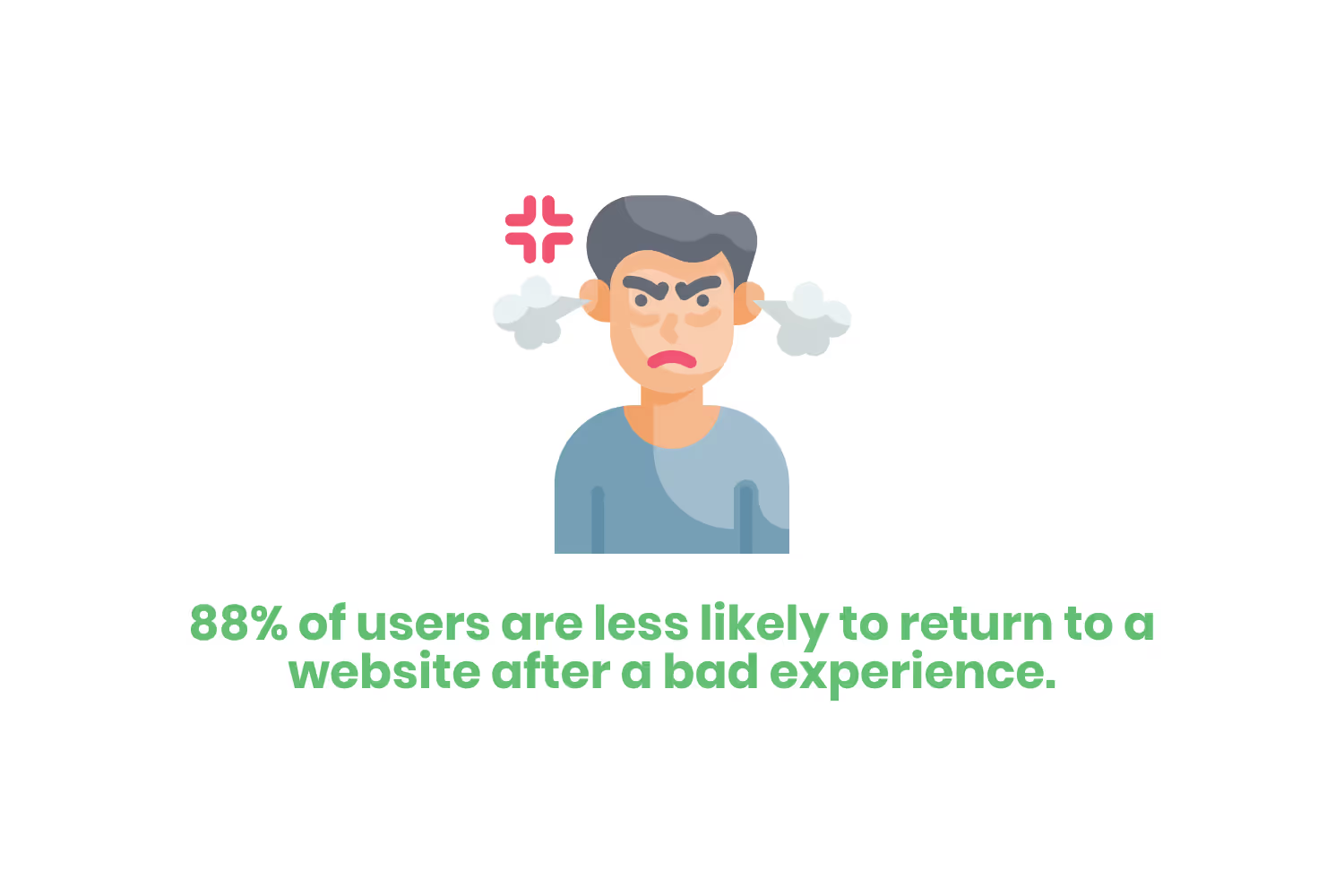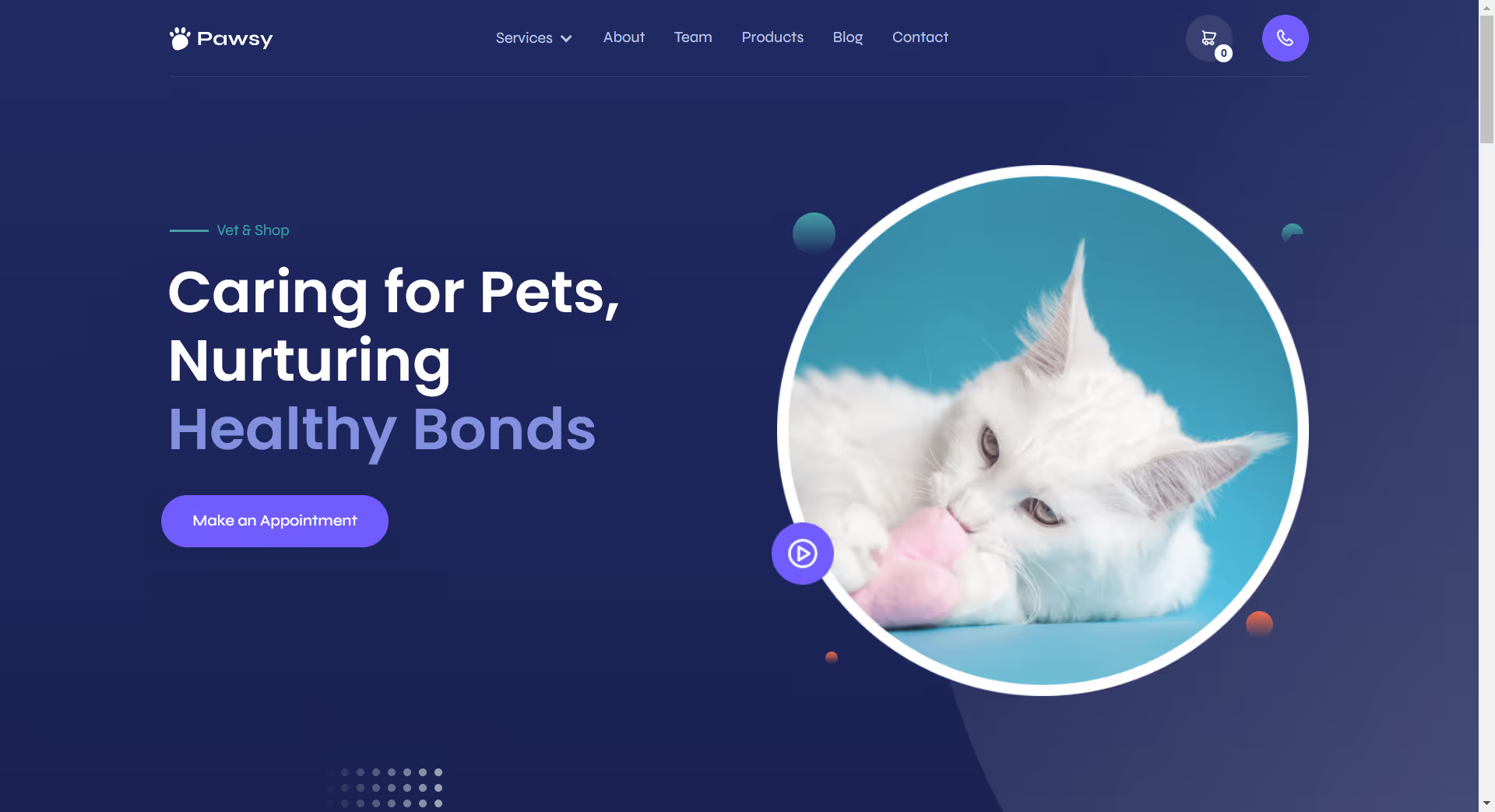Pawsitively Effective: The Ultimate Guide to Veterinary Marketing Strategies
For this blog post, we’ve put together an ultimate guide to veterinary marketing strategies.

70% of households in America own a pet.
That’s not only encouraging news for the domesticated animals of the world who need a home but also for the hundreds of thousands of veterinary clinics scattered across the country.
In other words, if 70% of households own a pet…70% of them also need to ensure that their pet(s) receive adequate veterinary care.

At its core, that’s a business opportunity. I’ll admit that you most likely didn’t start a veterinary practice with the same mindset and large corporations. Revenue isn’t what drives you…your love for animals is your primary motivation.
However, revenue IS what helps keep your lights on and helps support you financially.
So, part of running a veterinary clinic means implementing similar strategies that for-profit entities survive and grow off of.
Out of all of the different strategies that exist in the business world, the most effective set derives from marketing.
Luckily, marketing concepts don’t really change across industries. All you have to do is make minor tweaks and adjustments to them based on your organization’s niche.
What “minor tweaks” am I talking about? Don’t worry. For this blog post, we’ve put together an ultimate guide to veterinary marketing strategies.
The Importance of Veterinary Marketing
Veterinary marketing is nothing more than mixing together new and traditional techniques and rescoping them to attract new clients.
But, how effective is marketing?
Let’s take a look at the Super Bowl. That’s always a fun way to explain marketing’s effectiveness.
There’s a reason why a 30-second Super Bowl ad in 2023 had a price tag of $7 million. Companies don’t just invest that much money into advertisements that cost that much because they like football.
Studies show that word-of-mouth increases by 22% the week after their ad spot.
Word-of-mouth marketing also happens to be one of, if not the most effective form of marketing. Studies show that 92% of consumers believe suggestions from friends and family more than advertising.

113 million people watched Super Bowl LVII. With the numbers and percentages that I just threw out, you can see why so many companies buy Super Bowl ad spots.
But, let’s be more realistic. You’re most likely not going to buy a Super Bowl advertisement.
Yet, you can harness the power of marketing via advertising very easily through Facebook. Facebook ads are much more affordable and can be super effective. After all, digital ads increase brand awareness by 80%.
Although I’ve only talked about advertising in this section. There’s so much more to veterinary marketing. We’ll get into the other aspects later in this blog.
But, there’s a reason behind the healthcare industry’s intention to boost its marketing budget by 10%.
Understanding Your Audience: Pet Owners and Beyond
To make the most out of your marketing efforts, you need to make sure that you understand your audience.
If you just jump into marketing without catering it to the people who would be most interested in the services your clinic provides, you won’t realize as many benefits.
So, let’s go ahead and define your target audience. On a general level, your marketing efforts should target pet owners. That’s helpful, but it doesn’t really provide you with much insight.
Depending on where you’re located, your audience might have different preferences.
For example, maybe the pet owners near your clinic prioritize convenience and modern technology. If that’s the case, then you should ensure that your messaging speaks to their preferences. Thus helping you build a stronger connection and engagement with your audience.
You should also dissect the needs of different pet owner segments. Doing so provides insights into the types of services that they seek from a veterinary clinic. Recognizing the distinct needs of the pet owners in your area allows you to design services and communication that address their concerns directly. Catering to them in this way leads to a more personalized and empathetic approach to your marketing efforts…which builds trust and loyalty among your target audience.
This is all helpful information to know, but how do you figure out the wants and needs of your local pet owner community?
There are 8 ways to do it…
- Demographic Profiling: Look at the age, gender, income levels, family structure and educational background of your local community.
- Geographic Analysis: Map out neighborhoods, towns, or regions your clinic serves.
- Psychographic Insights: Uncover your local audience’s lifestyles, values, hobbies, interests, and attitudes toward pet care.
- Behavioral Patterns: Does your local community frequent pet stores, attend pet-related events, or engage in pet-focused social media groups?
- Competitor Analysis: Look at competing veterinary clinics in your area. Find out gaps in their strategy and fill them at your organization.
- Surveys and Feedback: Gain firsthand insights into the pain points, expectations and unmet needs by engaging directly with pet owners through surveys.
- Data Mining and Analytics: Extract valuable insights from online platforms, social media and website traffic to get a feel for user behavior and engagement.
- Cultural Sensitivity: Acknowledge cultural holidays, traditions, and preferences that may influence pet care decisions within your local community.
Working through these aspects listed above will give you a comprehensive understanding of the pet owners within your local community. You’ll build stronger connections, foster trust and position your clinic as an integral part of their pet ownership.
Branding and Identity for Veterinary Clinic
Let’s face it. Branding matters.
Studies show that a consistent brand presentation increases revenue by up to 33%.
In other words, creating a strong brand identity for your veterinary clinic presents a great growth opportunity for your organization. Luckily for you, coming up with a cool brand and/or logo for a vet is easy.

The image above is a great example of pulling off stellar branding for a veterinarian clinic. Wyoga Veterinary Hospital in Ohio has a great logo that’s memorable and unique.
But branding also involves your organization’s identity. In other words, it even extends to how your organization portrays itself on social media.

Let’s continue on with our example and take a look at how Wyoga Veterinary Hospital portrays itself on social media. You can tell their brand identity immediately on the latest post they made. This is obviously a repost of a meme, but it further solidifies their pet-friendly and approachable brand identity!
Building a Stellar Online Presence
The last section is the perfect segway into this one.
Running a successful business goes hand in hand with having a stellar online presence. Coincidentally, we looked at two important aspects associated with building an online presence in the last section.

But, they’re so important that we ought to go through them in more detail.
First and foremost, the starting point for building an online presence is your website. Having a website is one thing, but it won’t do you any good if it’s not user-friendly or modern. After all, 88% of users are less likely to return to a website after a bad experience.
What does a good website look like? Well, you could refer to the example screenshot from Wyoga Veterinary Hospital. Or, you could look at the new example image below.

Once you have a modern-looking website that’s also reflective of your brand, it’s time to focus on social media.
Social Media
Social media veterinary marketing strategies are very straightforward. You could follow in the footsteps of Wyoga Veterinary Hospital and post funny memes surrounding animals. Or, you could post community-based content like a “pet spotlight”.
Ideally, you would use several different types of social media posts and post consistently. But, if you’re just starting out, pick a few different types and post when you have time.
Blogging
If you asked 10 different marketing professionals what the best way is to drive traffic organically to your website, they would all give you the same answer. Blogging.
People are constantly searching on their favorite search engines for information and answers to questions. Each of those search engines keeps track of what phrases people search for. The industry term for these phrases is keywords.
You can take a look at those metrics that search engines provide, turn them into blog post ideas and then drive traffic to your website. That process is exactly what I used to get you to this blog post, actually.
Search Engine Optimization (SEO) for Veterinary Clinics
Another perfect segway from the last section to this one. Part of the blogging strategy that I just went through deals with search engine optimization (SEO).
SEO is an acronym that’s used to describe the process of optimizing your website to land better on search engine results pages.
Although it sounds technical, it's not as difficult as you might think and we kind of went through it already.

Keywords and Keyphrases
Rather than finding keywords and writing about them in a blog, you can also sprinkle them throughout your web pages. Some examples of the keywords you should include are things like “pet care” and “veterinary services”.
Integrating these keywords naturally into your website’s content and service pages will make a big difference in attracting more clients.
Local SEO
Although you should integrate industry-related keywords throughout your website, the real value of a local veterinary clinic comes from local SEO.
There are definitely people searching for “veterinary clinic in [your city]” and you should absolutely take advantage of that. Keywords that relate specifically to your services within your local community are extremely high value.
Additionally, Google also has a feature called Google My Business. To explain it, let’s bring up our favorite example.
If you googled the phrase, “veterinary wyoga” it would look something like the image above. That area on the right-hand side that provides overview information about Wyoga Veterinary Hospital goes by the name of Google My Business.
This is a feature that Google provides to businesses and it further enhances their local SEO efforts. You could register your clinic with Google My Business today and instantly enhance your local SEO performance.
Email Marketing and Client Engagement
Imagine having a community of local pet owners who actively want to hear from your business about updates, events and content that you publish.
Think about how beneficial that could be for your business.
The good news is that what I’m describing is essentially email marketing and it works extremely well in converting new business. In fact, the average ROI from email marketing is $36 for every $1 spent.

You simply don’t see returns that high from any other marketing strategy.
It’s also easy to implement.
All you have to do is add a form on your website where people can sign up for your organization’s newsletter by entering their name and email.
As you’re creating content and driving traffic to your website, visitors will naturally start signing up for your newsletter.
Meanwhile, you’re creating consistent content on your website because of the value it brings (per an earlier section of this blog).
So, that’s exactly what you should send your newsletter signups. Send them a summary of a new blog post, or prompt them to watch a video that you created to nurture your audience.
Then you can turn them into converting clients when your clinic runs a promotion.
Email marketing isn’t difficult, you just have to be consistent with it.
Online Reviews and Reputation Management
To put it simply, online reviews can make or break your organization. Don’t believe me?
40% of people believe that online reviews are very important when making decisions about pet care services.
I don’t blame them for placing so much value on your clinic’s reviews, do you? I mean, they want to make sure that their pet(s) get the best care possible.
That’s not to say that your organization doesn’t provide great care if it has bad reviews. What it is to say, though, is that reviews are a word-of-mouth type first impression of your clinic.

So, how do you foster an experience that leads to better reviews? It’s pretty simple, actually.
Reputation management all starts with encouraging feedback. If you actively ask and direct your most loyal clients to leave you a good review, they’ll most likely do it.
You may encourage your newer clients to leave you a good review as well, but it might take a little bit more work to get them to follow through. To encourage the more stubborn or non-tech-savvy clients to leave a review on your clinic, all you have to do is provide an incentive.

The image above is an example of offering an incentive if a user receives a review. Anyone who leaves a review for this organization would receive a $10 Amazon gift card. Who wouldn’t take you up on that offer?
Community-Driven Marketing
I’ve harped on this a lot throughout this blog post already, but a lot of your success comes from your local community.
Since they’re such an important driver of your clinic’s success, you need to get involved.
Rather than going to or sponsoring other local events, why not host your own and make it pet related?

People love finding new things to do with their pets, especially if they’re related to holidays. Why not host a pet costume contest during Halloween? Or, dress someone up as Santa and host an event where pets get their picture taken with him?
There are other types of events you could host, but start with the ones that will draw crowds the fastest. After all, you don’t want to do all the planning and work to organize an event only to have low attendance.
But don’t let that last sentence discourage you from hosting community events. After all, 31% of marketers agree that events are the most effective marketing channel.
Case Studies: Successful Veterinary Marketing Campaigns
A lot of marketing surrounds social proof. You provide great care at your clinic, you just have to make it known to the world.
One of the most effective ways to supply proof that the services your clinic provides are great is through the creation of case studies.
Odds are, you’ve had a lot of both interesting and life-saving cases come through your clinic. These stories are not only “feel-good”, but they’re also captivating.

Why not create a video and/or a document that explains these stories and real-life examples of the services you provide?
The technical term for these are case studies and they work really well.
They showcase the success of the treatment that your clinic provides. Just make sure you ask the pet owner for consent before writing about their pet.
Studies show that 63% of marketers say that case studies are effective in generating leads.
Conclusion
Utilizing the marketing strategies outlined in this blog post to elevate your veterinary clinic might seem like you have a lot of work ahead of you.
I can’t deny it, there’s a lot involved.
However, rather than viewing it as “work”, you should view it as a massive opportunity to grow your organization.
You also don’t have to implement everything at once. Pick a few of the strategies we went through that you think you can stay consistent with then slowly introduce more over time.
No doubt, you’ll see benefits from implementing these strategies. Just don’t overwhelm yourself.
Etactics offers marketing services to veterinary clinics. Whether you need help with creating content, managing your social media, or a website redesign, we can help grow your clinic.
Emphasize your product's unique features or benefits to differentiate it from competitors
In nec dictum adipiscing pharetra enim etiam scelerisque dolor purus ipsum egestas cursus vulputate arcu egestas ut eu sed mollis consectetur mattis pharetra curabitur et maecenas in mattis fames consectetur ipsum quis risus mauris aliquam ornare nisl purus at ipsum nulla accumsan consectetur vestibulum suspendisse aliquam condimentum scelerisque lacinia pellentesque vestibulum condimentum turpis ligula pharetra dictum sapien facilisis sapien at sagittis et cursus congue.
- Pharetra curabitur et maecenas in mattis fames consectetur ipsum quis risus.
- Justo urna nisi auctor consequat consectetur dolor lectus blandit.
- Eget egestas volutpat lacinia vestibulum vitae mattis hendrerit.
- Ornare elit odio tellus orci bibendum dictum id sem congue enim amet diam.
Incorporate statistics or specific numbers to highlight the effectiveness or popularity of your offering
Convallis pellentesque ullamcorper sapien sed tristique fermentum proin amet quam tincidunt feugiat vitae neque quisque odio ut pellentesque ac mauris eget lectus. Pretium arcu turpis lacus sapien sit at eu sapien duis magna nunc nibh nam non ut nibh ultrices ultrices elementum egestas enim nisl sed cursus pellentesque sit dignissim enim euismod sit et convallis sed pelis viverra quam at nisl sit pharetra enim nisl nec vestibulum posuere in volutpat sed blandit neque risus.

Use time-sensitive language to encourage immediate action, such as "Limited Time Offer
Feugiat vitae neque quisque odio ut pellentesque ac mauris eget lectus. Pretium arcu turpis lacus sapien sit at eu sapien duis magna nunc nibh nam non ut nibh ultrices ultrices elementum egestas enim nisl sed cursus pellentesque sit dignissim enim euismod sit et convallis sed pelis viverra quam at nisl sit pharetra enim nisl nec vestibulum posuere in volutpat sed blandit neque risus.
- Pharetra curabitur et maecenas in mattis fames consectetur ipsum quis risus.
- Justo urna nisi auctor consequat consectetur dolor lectus blandit.
- Eget egestas volutpat lacinia vestibulum vitae mattis hendrerit.
- Ornare elit odio tellus orci bibendum dictum id sem congue enim amet diam.
Address customer pain points directly by showing how your product solves their problems
Feugiat vitae neque quisque odio ut pellentesque ac mauris eget lectus. Pretium arcu turpis lacus sapien sit at eu sapien duis magna nunc nibh nam non ut nibh ultrices ultrices elementum egestas enim nisl sed cursus pellentesque sit dignissim enim euismod sit et convallis sed pelis viverra quam at nisl sit pharetra enim nisl nec vestibulum posuere in volutpat sed blandit neque risus.
Vel etiam vel amet aenean eget in habitasse nunc duis tellus sem turpis risus aliquam ac volutpat tellus eu faucibus ullamcorper.
Tailor titles to your ideal customer segment using phrases like "Designed for Busy Professionals
Sed pretium id nibh id sit felis vitae volutpat volutpat adipiscing at sodales neque lectus mi phasellus commodo at elit suspendisse ornare faucibus lectus purus viverra in nec aliquet commodo et sed sed nisi tempor mi pellentesque arcu viverra pretium duis enim vulputate dignissim etiam ultrices vitae neque urna proin nibh diam turpis augue lacus.




